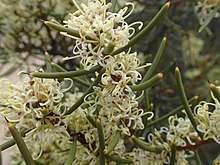Hakea preissii
Hakea preissii, commonly known as the needle tree,[1] needle bush and Christmas hakea,[2] is a shrub or tree of the genus Hakea native to Western Australia. The Noongar name for the plant is Tanjinn.[3]
| Needle bush | |
|---|---|
 | |
| Hakea preissii growing on the edge of Lake Hurlstone near Hyden | |
| Scientific classification | |
| Kingdom: | Plantae |
| Clade: | Tracheophytes |
| Clade: | Angiosperms |
| Clade: | Eudicots |
| Order: | Proteales |
| Family: | Proteaceae |
| Genus: | Hakea |
| Species: | H. preissii |
| Binomial name | |
| Hakea preissii | |
 | |
| Occurrence data from Australasian Virtual Herbarium | |
Description
Hakea preissii is a shrub or tree which typically grows to a height of 2 to 4 metres (6.6 to 13.1 ft). It has branchlets that are moderately to densely appressed-pubescent on new growth, quickly glabrescent, and glaucous in their second year. The rigid, simple leaves are rarely divided apically into 2 or 3 segments, 1 to 6 centimetres (0.4 to 2.4 in) in length and 1.5 to 2.5 millimetres (0.06 to 0.10 in) in width. Inflorescence are axillary with 4–28 yellow-green flowers with persistent pedicels 3.5 to 7 millimetres (0.14 to 0.28 in) long. Smooth grey to black fruit that are obliquely ovate or elliptic, dilated apically and approximately 2 centimetres (0.8 in) long and 1 centimetre (0.4 in) wide. It blooms from August to December.[4]
Taxonomy
Hakea preissii was first formally described by the botanist Carl Meissner in 1845 from a specimen collected in a forest near York. The description was published in Johann Georg Christian Lehmann's work Plantae Preissianae.[5][6][7] The specific epithet (preissii) honours Ludwig Preiss who collected plant specimens in Western Australia between 1838 and 1842.[4]
Distribution and habitat
Needle tree is endemic to an area in the Pilbara, Wheatbelt, Mid West and Goldfields-Esperance regions of Western Australia. It has a scattered distribution and is found as far north as Tom Price and south as Gnowangerup. It is found along the west coast and a little farther east than Kalgoorlie. The plant is found on plains and around the margins of salt marshes growing in sand, loam and sandy-clay soils.[1] It sometimes invades semi-arid pastoral land in Western Australia.[8]
Conservation
This species is classified as "not threatened" by the Western Australian Government Department of Parks and Wildlife.[1]
 Hakea preissii fruit
Hakea preissii fruit Hakea preissii habit
Hakea preissii habit
References
- "Hakea preissii". FloraBase. Western Australian Government Department of Parks and Wildlife.
- "Hakea preissii Meisn. Christmas hakea". The Atlas of Living Australia. Global Biodiversity Information Facility. Retrieved 20 June 2016.
- "Noongar names for plants". kippleonline.net. Archived from the original on 20 November 2016. Retrieved 8 December 2016.
- "Hakea preissii factsheet". Government of South Australia. Retrieved 20 June 2016.
- "Hakea preissii". APNI. Retrieved 18 October 2018.
- Meissner, Carl (1845). Plantae Preissianae. v.1. Hamburg: Sumptibus Meissneri. p. 557. Retrieved 18 October 2018.
- "Hakea preissii Meisn". Atlas of Living Australia. Global Biodiversity Information Facility. Retrieved 18 October 2018.
- Holm, Alexander M.; Shackleton, KR; Speijers, Jane (1993). "Control of Hakea Preissii (Meissner) and Associated Species by Fire in Degraded Semi-Arid Rangelands". The Rangeland Journal. 15 (1): 71–78. doi:10.1071/RJ9930071.